Driving With a Disability
Driving is often seen as a symbol of freedom and independence, but for millions of individuals around the world living with disabilities, it can also represent a unique set of challenges and triumphs. Driving with a disability often comes with physical and financial complexities that other drivers don’t face.

Legally Reviewed by:
Mark S. Gervelis, Esq.
Last Updated:
- October 29, 2025
However, these obstacles shouldn’t make people feel they can’t or shouldn’t drive. According to the Department of Transportation, around 65 percent of people with a disability in the United States drive a car. While drivers with disabilities have to meet safety and licensing requirements, the Americans with Disabilities Act says that no one can deny a driver’s license to someone based solely on their disability. If you have a disability and are ready to get on the road, understanding how your condition could affect your driving—and what you can do to drive more safely—is crucial.
Survey Results: Understanding the Driving Challenges of People with Disabilities
To better understand the driving challenges faced by individuals with disabilities, we surveyed 100 people to explore their experiences, concerns about safety, and the use of adaptive equipment. The findings offer important insights into both the physical and emotional obstacles these drivers encounter, highlighting areas where improvements in accessibility, infrastructure, and support could make a significant difference.
Demographics of Survey Respondents: Key Insights into Disability and Driving
The average age of respondents was 41.5 years, with a diverse mix of genders, education levels, and household incomes. The majority identified as White (50%), followed by Black/African American (27%) and Hispanic (14%). In terms of disabilities, visual impairments were the most common (36%), followed by mobility impairments (25%) and cognitive/neurological conditions (20%).
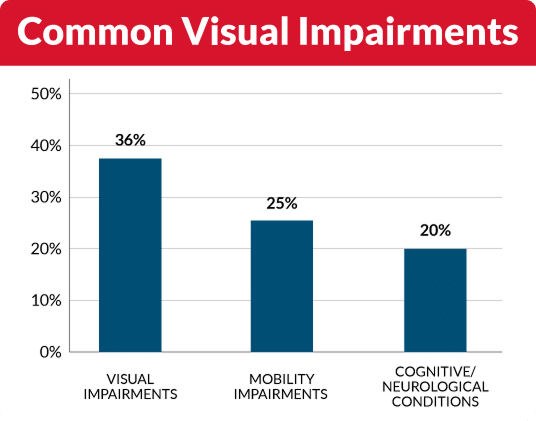
Notably, 43% reported that their disabilities significantly impacted their driving experience.
Do you feel that your disability affects your ability to drive?
- Yes, significantly: 43%
- Somewhat: 30%
- Not at all: 16%
- Rarely: 11%
Driving Experience and Adaptive Equipment Usage Among Drivers with Disabilities
A significant portion of respondents (53%) used adaptive driving equipment, such as hand controls (17%) and specialized mirrors (15%). While many reported high confidence in their driving abilities, 63% cited anxiety or stress as a major driving challenge

When asked about the top challenges they face while driving, respondents highlighted several key obstacles that impact their experience on the road. The most common difficulties include emotional stress, physical strain, and issues related to accessibility and vehicle adaptation. Here’s a breakdown of the top challenges reported:
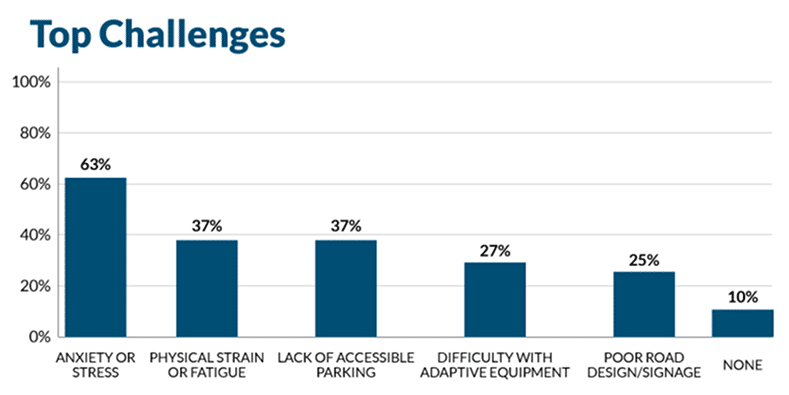
Common Driving Challenges Faced by Drivers with Disabilities:
Drivers with disabilities face a range of unique challenges when it comes to operating a vehicle. In addition to broader concerns like anxiety and physical strain, many encounter specific issues related to vehicle adaptation and infrastructure. Here are some of the most common driving challenges reported by respondents:
- Difficulty holding the brake
- Discomfort during long drives
- Limited accessible parking
- Trouble purchasing new vehicles adapted to needs
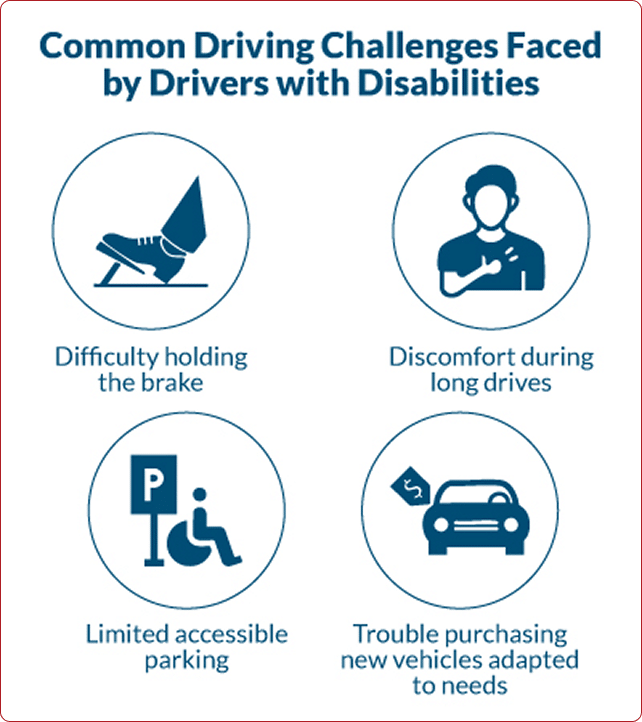
Over half of respondents expressed a need for better infrastructure, such as more accessible parking and improved road design.
Safety Practices and Desired Improvements for Drivers with Disabilities
The survey revealed strong safety practices among respondents, with 88% always using seat belts and widespread use of advanced safety features like backup cameras (70%) and blind-spot detection (51%). However, there is a clear demand for improvements in accessibility, adaptive technology, and driver training. Respondents overwhelmingly called for greater awareness and inclusion, particularly in terms of accessible parking and infrastructure.
Desired Improvements for Disability-Friendly Driving Environments:
- More accessible parking/infrastructure: 55%
- Increased public awareness/inclusion: 54%
- Improved adaptive equipment technology: 48%
- Better road design/signage: 42%
- Greater access to driver training/rehabilitation: 36%
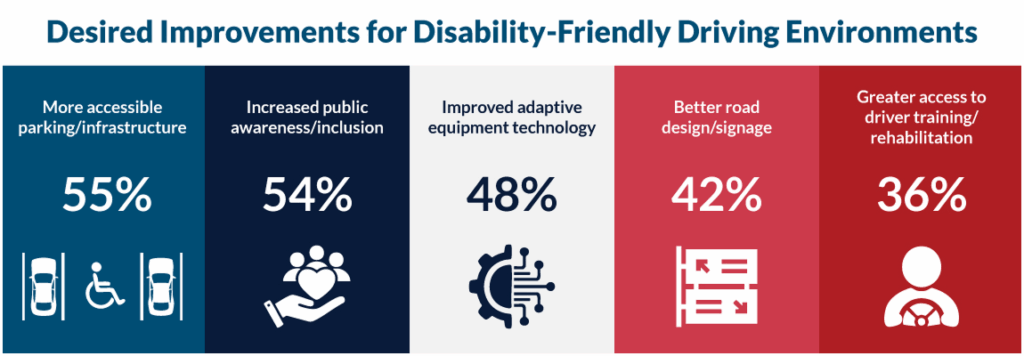
Key Insights on Driving Challenges and Opportunities for Improvement
- Disability and Driving Impact: Over 70% of respondents reported that their disability impacts their driving experience.
- Adaptive Equipment Usage: While adaptive equipment usage is common, it’s not universal. Half of respondents use such equipment, highlighting opportunities for increased awareness and accessibility.
- Stress and Fatigue: Anxiety while driving is a leading challenge, with 63% of respondents noting its impact.
- Driver Confidence: Despite challenges, most drivers feel confident in their ability to drive.
- Safety Awareness: High levels of safety-conscious behavior were observed, including regular seat belt use, reliance on adaptive safety features, and cautionary driving in challenging conditions.
- Need for Infrastructure and Training: There is a clear demand for better parking, improved roads, and more inclusive driver education and rehabilitation programs.
Driving With Mobility Issues
Conditions that affect a driver’s mobility can make it difficult to operate a vehicle. For example, millions of Americans have arthritis, which causes inflammation of the joints, severe pain, and stiffness. These symptoms can make it difficult to turn your head when backing up or checking your blind spots. You might also struggle to grasp the steering wheel, use turn signals, or wear a seatbelt.
Amputees or those with paralysis in one or more limbs also encounter challenges. Depending on the type and location of your amputation, you might have trouble turning a steering wheel, shifting gears, or pushing the brake pedal. Likewise, individuals with paralysis in their legs or lower body often can’t operate standard vehicles with foot pedals for braking and acceleration.
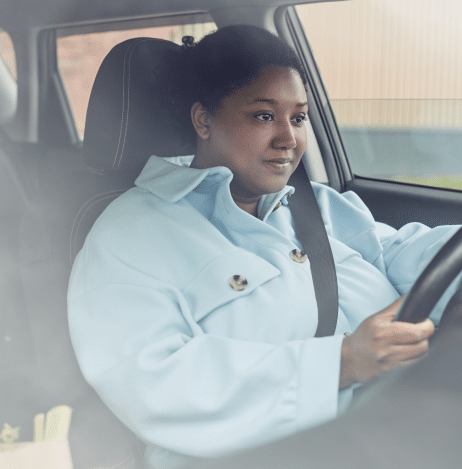
Driving With Vision Issues
The ability to clearly see your surroundings is essential for driving, so much so that many states require people to complete a vision test when applying for a license. People with color vision deficiencies, for instance, see colors differently. If your condition is severe, you might struggle to identify traffic light colors or see brake lights.
Some people also have visual field loss, meaning they can’t see all their surroundings. A reduced visual field makes it more difficult to see oncoming traffic and spot hazards on the road.
Driving With Neurodivergent Conditions
Neurodivergent conditions, which affect how the brain functions and processes information, can also introduce complications when driving. These conditions include:
- Attention deficit hyperactivity disorder, or ADHD: People with ADHD might struggle to pay attention for extended periods or experience hyperactivity and impulsivity. All those factors can lead to distraction, excessive movement, and slower reaction times while driving.
- Autism: Autism can affect motor coordination and sensory processing. When driving, that could cause issues when changing lanes, turning the steering wheel, or coping with loud traffic noises.
- Stroke: Even after recovery, many stroke victims have ongoing weakness, paralysis, and numbness. When paired with reduced concentration, those physical struggles can make it difficult to respond to other cars on the road, obey traffic signals, and drive smoothly.
- Parkinson’s disease: Parkinson’s disease affects the nervous system and can cause a person’s arms, legs, or hands to shake unexpectedly, sometimes leading to slower reaction times. Problems with depth perception can become an issue when changing lanes or parking.
Another common concern for neurodiverse people is overstimulation. If you have one of these conditions, loud traffic or shining headlights might create discomfort while driving.
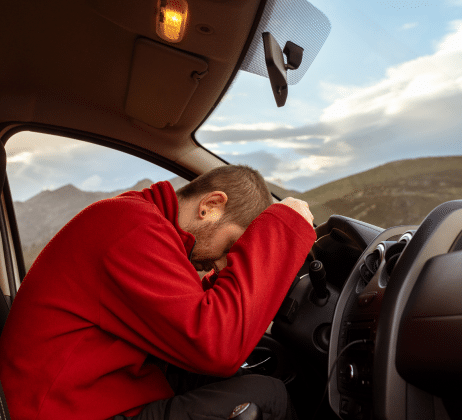
Driving With Psychiatric Conditions
While they often aren’t visible to others, mental health conditions can also make driving more challenging. For example, people with anxiety might get overwhelmed by traffic, unfamiliar routes, or weather conditions. In Ohio, driving during the winter is notably more difficult than in fairer weather conditions. Anxiety can also cause shortness of breath and lightheadedness, making it harder to stay focused and alert when driving.
Depression can have similar effects, especially if one has difficulty sleeping. When someone suffers from severe depression, they might also feel less concerned about their safety or the possibility of an accident.
Other Medical Conditions
Additional medical concerns that could affect a person’s driving include:
- Diabetes: If you have diabetes and your blood sugar suddenly drops, you might experience dizziness or lose consciousness. Some people with diabetes also sustain nerve damage in their feet and legs, making it harder to control the foot pedals in a car.
- Epilepsy: Epileptic seizures can cause drivers to lose consciousness or muscle control while driving. Epilepsy is also known to affect memory and attention, which interferes with a driver's focus.
- Heart issues: People with heart conditions might experience sudden symptoms while driving. For example, if you have an irregular heartbeat, also known as arrhythmia, you might unexpectedly faint while behind the wheel.
- Hearing loss: People who struggle to hear the sounds around them might have difficulty focusing on what's in front of them. In addition, drivers with hearing impairments may not notice sirens and car horns alerting them to incoming dangers.
Getting input from your doctors is vital when deciding whether these or other medical conditions will affect your driving ability.
Vehicle Modifications and Adaptive Driving Equipment To Help Drivers
Although they might have to navigate some extra obstacles, many people with disabilities can drive because of specialized equipment and vehicle modifications. Even small changes to a car can create a safer, easier driving experience.
Common Solutions for Drivers With Disabilities
Many tools are now available that allow people with disabilities to operate vehicles. For instance, hand controls and pedal extenders assist with controlling a vehicle’s speed.
Drivers with limited arm or hand strength can benefit from steering aids that reduce the force necessary to turn the steering wheel. If you use a wheelchair or other mobility device, you can add lifts and ramps that enable you to enter and exit your vehicle without assistance.
In some cases, drivers may need to modify their vehicle’s overall structure to make it more accessible. For example, lowering the floor or raising the roof is sometimes necessary to accommodate wheelchairs and other mobility devices.
Paying for Vehicle Modifications
Making these adjustments or buying a new vehicle with adaptive equipment can be expensive. Unfortunately, many people don’t have the resources to pay for these costs out of pocket.
Drivers who need financial support for vehicle modifications can contact certain government agencies, such as Ohio’s Bureau of Vocational Rehabilitation or the U.S. Department of Veterans Affairs. As part of their disability advocacy, these agencies provide resources regarding grants and other assistance that can cover the cost of vehicle modifications.
Some nonprofit organizations also help drivers access the modifications and tools they need. Your state government can generally provide a list of resources available in your location.
Risks on the Road and How To Mitigate Them
Driving can be dangerous for anyone—not just those with disabilities. However, ensuring safety on the road while having a disability might require some extra planning.
Potential Dangers When Driving
Breakdowns and accidents are often more than just an inconvenience if you have a disability. For example, a driver who uses a wheelchair may find it more difficult to escape a vehicle after an accident.
Unsafe weather conditions, including rain, ice, and snow, can also pose additional challenges for those with disabilities. They can make it more difficult to maintain control while driving and get into and out of a vehicle. Some weather events could also leave you temporarily stranded and unable to access shelter, food, or supplies.

Vehicle Safety Checklist
Preparation is key to helping drivers avoid and overcome these risks. Before heading out on your next trip, make sure you’ve taken care of all the following items on this checklist:
- Inspect the vehicle’s interior and exterior before every trip.
- Select adaptive equipment that allows you to operate the vehicle safely and legally.
- Bring backup medications when traveling in case you become stranded.
- Carry water wherever you go to avoid dehydration, which can worsen many medical conditions.
- Assemble a safety kit with hot and cold packs, first aid supplies, and any tools you might need to repair your assistive devices.
- Research the accessibility of your destinations, including whether they have grab bars in the bathrooms and accessible parking.
- To prepare for hazardous weather conditions, pack essential items such as a flashlight, non-perishable food, and rain gear.
If some of these tasks aren’t practical for you because of your disability, ask a friend or family member to help you prepare for travel.
Driving License and Handicap Permit Requirements
Licensing and permit requirements differ from state to state, so people with disabilities and their caregivers need accurate information. Consult your area’s local authorities or licensing agencies to determine what requirements and procedures apply to your situation.
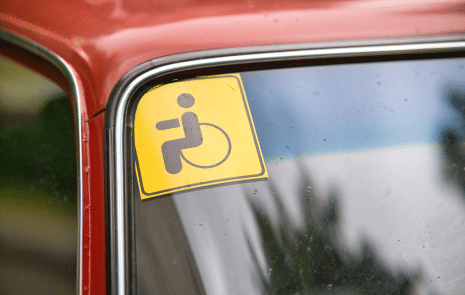
Obtaining a License
Most states require people to take a written exam and a road test when applying for a driver’s license. Some may also require applicants to complete a certain number of supervised driving hours or a driving education course. When taking your road test, the examiner must see your adaptive driving in action. Make sure that you’ve finished modifying your vehicle before scheduling the exam
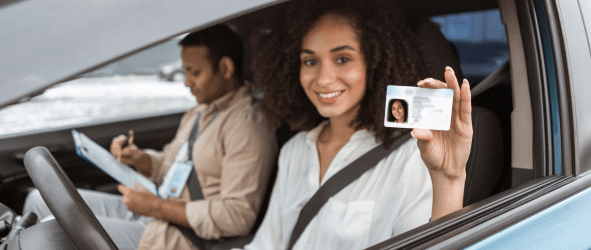
Applying for a Parking Permit
A handicap parking permit may be a blue and white hanging placard or a designation on your license plate. It allows you to park in specific spots closer to a building’s entrance.
State governments issue handicap parking permits separately from licenses. To qualify for one, you must demonstrate that you have a disability affecting your mobility or making it difficult to walk long distances.
In addition to using a handicap parking permit, people with disabilities can also request a national disability ID through the Invisible Disabilities Association. This voluntary card indicates that you have a disability so law enforcement and first responders know about your condition during traffic stops and emergencies.
Legal Options if You're Involved in an Accident
If you’re harmed in an accident while driving with a disability because of someone else’s negligence, you can hold the responsible parties accountable. You might be eligible to pursue a personal injury claim and seek damages for your medical expenses, lost wages, pain and suffering, and other losses.
Gervelis Law Firm helps victims of car accidents through every stage of their cases, from investigating and gathering evidence to negotiating with insurance companies and fighting for them in court.
